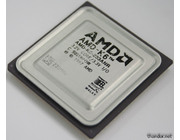As mentioned here I have a few 233MHz-rated AMD K6 chips with slight differences in appearance.
This particular model is made in the 49th week of 1997 and has the regular AMD K6 print with just the QR-code in the left bottom. Older models don't have the QR-code and newer models have both the QR-code and speed-rating engraved. This was done to prevent tampering with the printed logo: it was easy for scammers to reprint a 200MHz logo on a 166MHz chip and sell it with a higher margin. The engraved speed-rating is far more difficult to falsify. > Read more
I have a few AMD K6 233MHz chips yet not all of them are the same. For instance: this particular model has the regular/common style printed small logo but lacks the engraved MHz-indication and QR-code. AMD added this engraved identification because it makes it more difficult to create false prints. Back in the day it was not uncommon that people would buy 166 or 200MHz parts and change the modelnummer to 233MHz and just resell it as a 233MHz part for more profit.
This particular chip also appears to be NOS (New Old Stock) and therefore has never been used. Most used chips will have a damaged print. > Read more
This appears to be a never used (NOS) AMD K6 chip. It runs at 233MHz and also has the engraved speed marking + QR code in the left bottom. > Read more
A somewhat rare AMD K6 because it has a 'big style' K6-logo. Compare with the other related CPU's and see the difference. The difference is only optical. In other words: the chip itself is identical to any other normal K6-233.
> Read more
Just like the 166MHz model but somewhat faster. > Read more
Although the codename of this CPU is 'Little foot' it isn't just the same as the AMD K6 166, 200 and 233 with ANR. This one has been made on 250nm and uses 2,2V. Performance would be equal to a 266MHz 'old' Little foot but heat generation is far less. Because of this AMD could also crank up this CPU to 300MHz. > Read more
Just like this AMD K6 166ALR but then faster and hotter. The AMD K6 233 runs like hell if it comes down to integer performance (which you'll notice in Doom and Windows) but is somewhat poor with floating point (FPU) calculations. In case you want to play 3D-games like MDK or Quake the AMD K6 was not the CPU you wanted. Compare the K6 233 with the Pentium MMX 233 for example ![]() .
.
The heatspreader of the K6 233 indicates the CPU needs 3,2V to run correctly. 3,2V is more than the Pentium MMX or the K6 166. It looks like AMD had problems reaching higher clock frequencies and increased the default voltage in order to maintain stability. Although my QDI Explorer II DM250 motherboard did not support 3,2V for the AMD K6 it ran just fine at 2,9V. Maybe I was lucky.
There is also an AMD K6 233AFR which uses 2,2V and has been made with a 250nm process. > Read more
AMD had lot's of trouble with the AMD K5 and nearly went bankrupt. To find a way out they bought NexGen (which also had engineers that worked on the Pentium) that was developing the Nx586 and Nx686 which are quite hard to get these days. AMD put the NexGen team on the K6 project and let them build the CPU.
The result was a decent CPU that could compete with the Pentium and that was compatible with socket 7 motherboards. Because of this AMD didn't have to worry about motherboards and could use the existing established platform that everyone used in the day. If AMD had to develop their own motherboards (or license them to other brands for manufacturing) then prices would be higher due development costs and extra production lines and the diversity of motherboards would be far less. > Read more









